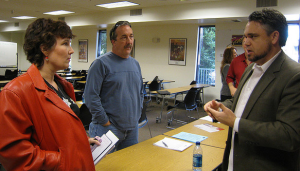 photo by Dru Bloomfield / Flickr Creative CommonsThe Harvard Business Review in its June 2012 issue published an article called "Leadership Is a Conversation" by Boris Groysberg and Michael Slind. They start by saying the old "command-and-control" model of business administration has given way to other models.
photo by Dru Bloomfield / Flickr Creative CommonsThe Harvard Business Review in its June 2012 issue published an article called "Leadership Is a Conversation" by Boris Groysberg and Michael Slind. They start by saying the old "command-and-control" model of business administration has given way to other models.
They write:
"Smart leaders today, we have found, engage with employees in a way that resembles an ordinary person-to-person conversation more than it does a series of commands from on high. Furthermore, they initiate practices and foster cultural norms that instill a conversational sensibility throughout their organizations. Chief among the benefits of this approach is that it allows a large or growing company to function like a small one. By talking with employees, rather than simply issuing orders, leaders can retain or recapture some of the qualities—operational flexibility, high levels of employee engagement, tight strategic alignment—that enable start-ups to outperform better-established rivals."
I couldn't help in reading this but to feel a resonance with the basic premise of restorative practices, that "people are more cooperative and productive, and more likely to make positive changes, when those in authority do things with them rather than to them or for them."
A restorative conference is a conversation between victims, offenders and their circles of support, to gain a better understanding of what has happened and move toward restoring the harm. Circles in schools, at colleges, in workplaces and other settings are conversations that proactively build community or respond to harm and wrongdoing. More informal restorative practices, like small impromptu conferences and the use of restorative questions, encourage people to express their feelings and thoughts to one another. At the organizational level, the types of conversation Groysberg and Slind advocate seem consistent with the restorative vision of a company that takes input from all its employees, involving employees in a meaningful way in the business of the company and in working through conflict.
Slind and Groysberg go on to identify "four elements of organizational conversation that reflect the essential attributes of interpersonal conversation: intimacy, interactivity, inclusion, and intentionality" and discuss what these concepts mean.
The full article is accessible only to subscribers but may also be purchased as a pdf.
Read the story and listen to a free podcast with the authors speaking about their new book, Talk, Inc., here.
Thanks to Mark Finnis for posting the story on his useful twitter feed @markfinnis
